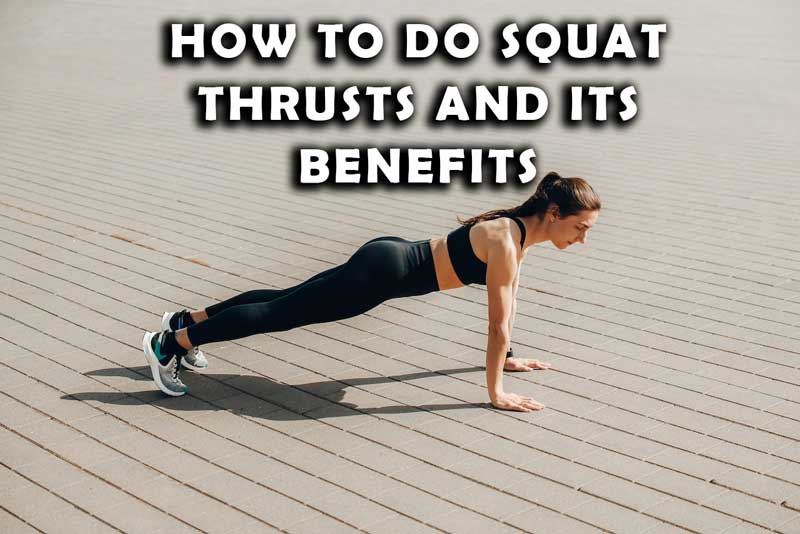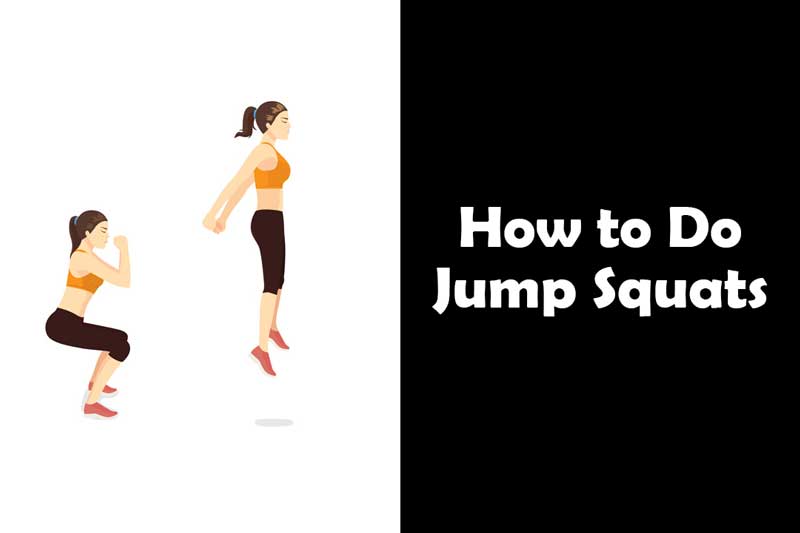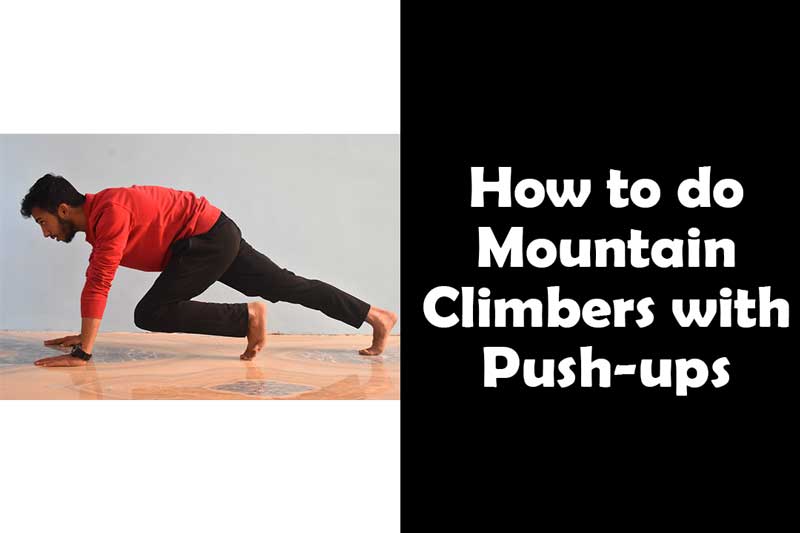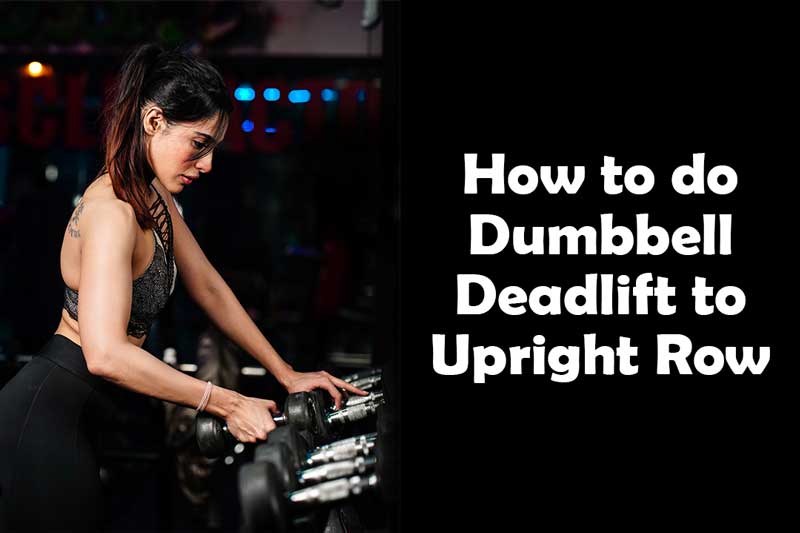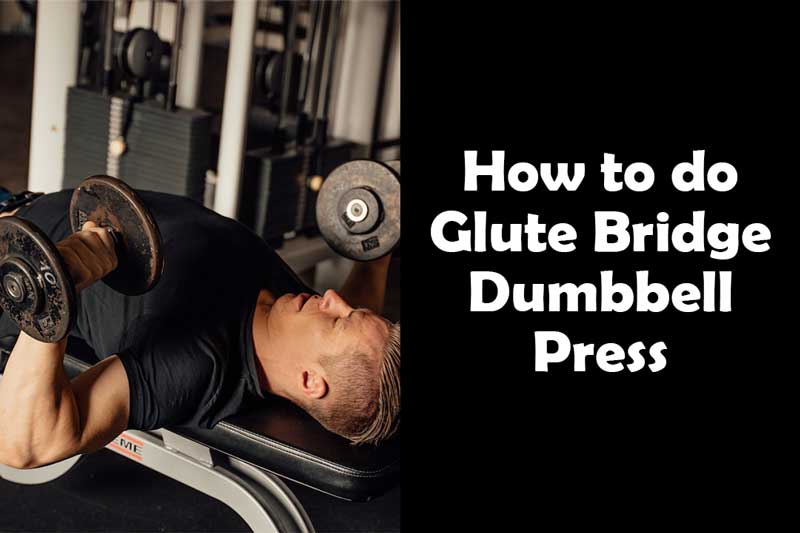Looking for a beginner friendly full body exercise, you are at the right place. Squat thrusts are really amazing full body exercise that doesn’t require any equipment and has various benefits.
Squat thrusts are an effective full-body exercise that can help you tone muscles, increase strength, and improve cardiovascular endurance.
This article will guide you on how to perform squat thrusts correctly and highlight the many benefits and variations that come with incorporating this exercise into your workout routine.
What are Squat Thrusts?
Squat thrusts are a bodyweight exercise that involves moving from a standing position to a plank position and back up again.
However, this exercise requires no equipment and you can do it anywhere, making it a popular choice for those looking to work out at home or on the go.
How to Do Squat Thrusts Perfectly?
Proper Squat Thrust Form
Follow these steps to perform squat thrusts correctly:
- Begin in a standing position with your feet shoulder-width apart.
- Then, lower your body into a squat position, placing your hands on the ground in front of you.
- Kick your legs back into a plank position, keeping your core engaged and your back straight.
- Quickly jump your legs back up towards your hands, returning to a squat position.
- At last, stand up straight, lifting your arms overhead to complete one rep. Lifting your arms overhead is optional.
Common Mistakes to Avoid
Here are some common mistakes to avoid when doing squat thrusts:
- Arching your back: Keep your back straight throughout the exercise to avoid straining your lower back.
- Bending your knees too much: Make sure your knees are bending slightly in the squat position, but not so much that your heels lift off the ground.
- Allowing your hips to drop: Keep your core engaged and your hips level when in the plank position to avoid placing unnecessary stress on your lower back.
- Going too fast: While squat thrusts are a high-intensity exercise, it’s important to maintain proper form and not sacrifice technique for speed.
Benefits of Squat Thrusts
Incorporating squat thrusts into your workout routine can provide the following benefits:
1) Builds Full-Body Strength
Squat thrusts engage multiple muscle groups, including your arms, shoulders, core, glutes, and legs.
This exercise strengthens these muscles and can help you achieve a leaner, more toned physique.
2) Burns Calories and Fat
Squat thrusts are a high-intensity exercise that burns a significant number of calories in a short amount of time.
The more you do it the more it will get challenging and the more calories you will burn. Therefore, it can help you achieve your weight loss goals and reduce body fat.
3) Improves Cardiovascular Endurance
Squat thrusts are a cardiovascular exercise that gets your heart rate up and increases your stamina.
Regularly incorporating squat thrusts into your workout routine can improve your overall cardiovascular health and endurance.
4) Enhances Flexibility and Mobility
Squat thrusts require you to move through a full range of motion, which can enhance your flexibility and mobility.
So, this exercise can improve your joint health and prevent injuries.
Squat Thrust Muscles Worked
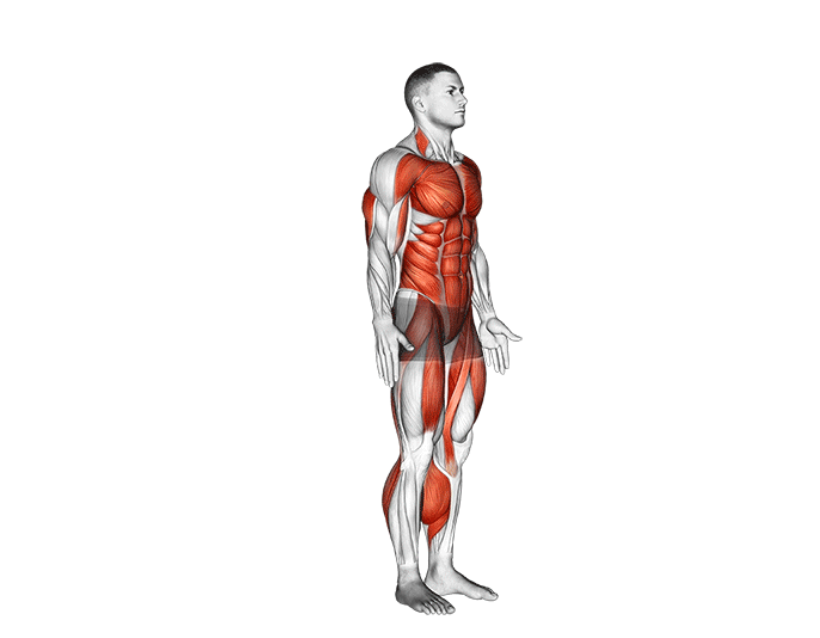
Squat thrusts are a compound exercise that work multiple muscles throughout the body. Many big and small muscles are engaged while doing this exercise. However, here are the specific muscles that are worked during a squat thrust:
1. Quadriceps
The quadriceps are a group of four muscles located at the front of the thigh. They are responsible for extending the knee and are worked during the squat portion of the squat thrust.
2. Glutes
The glutes are the muscles in the buttocks that help with hip extension and stabilization. They are worked during the squat and jump portions of the squat thrust.
3. Hamstrings
The hamstrings are a group of three muscles located at the back of the thigh. They are responsible for flexing the knee and extending the hip. They are worked during the jump portion of the squat thrust and when you bend down to reach the floor.
4. Abdominals
The abdominals are the muscles in the midsection of the body that help with core stabilization and spinal flexion. They are worked during the plank portion of the squat thrust.
5. Lower back
The lower back muscles help with spinal extension and stabilization. They are worked during the plank portion of the squat thrust.
6. Shoulders
The shoulders are worked during the plank portion of the squat thrust, as they are responsible for stabilizing the upper body in a push-up position.
7. Chest
The chest muscles are also worked during the plank portion of the squat thrust, as they are responsible for pushing the body away from the floor.
Squat Thrust Variations
Here are some variations of the squat thrust that you can try:
1) Burpee
Add a jump and a push-up to the traditional squat thrust for an even more intense full-body workout.
2) Jump squat thrust
Instead of returning to a standing position after each rep, jump up as high as you can.
3) Add A Push-Up
Instead of just doing plank and then standing up, add a push up and then stand up.
4) Squat thrusts with dumbbells
You can make squat thrust more challenging by incorporating dumbbells into the exercise. Adding weights can help increase the resistance and intensity of the exercise, making it a great option for those who want to build more strength and muscle.
To do squat thrusts with dumbbells, follow these steps:
- Stand with your feet shoulder-width apart, holding a dumbbell in each hand at your sides.
- Lower your body into a squat, keeping your back straight and your chest up. Hold the dumbbells in front of your thighs.
- Place the dumbbells on the ground and jump your feet back into a plank position.
- Lower your body into a push-up, keeping your elbows close to your sides.
- Push your body back up into a plank position and jump your feet back up to your hands.
- Stand up and lift the dumbbells back to the starting position.
Incorporating dumbbells into your squat thrusts can help you build more strength and muscle in your upper body, while also providing the full-body benefits of the exercise. Try adding them to your next workout for a challenging and effective exercise.
Incorporating Squat Thrusts Into Your Workout Routine
You can do squat thrust as a standalone exercise or as part of a larger workout routine. Here’s an example of how you can incorporate squat thrusts into your routine:
- Warm-up: 5 minutes of light cardio, such as jogging or jumping jacks.
- Squat thrusts: 3 sets of 10 reps, with 30 seconds of rest between each set.
- Strength training: 3 sets of 10 reps of exercises such as push-ups, lunges, or dumbbell rows.
- Cardiovascular exercise (Cardio): 10-20 minutes of high-intensity interval training (HIIT), such as running sprints or cycling.
This beginner friendly routine. You can increase it more if you are used to it and or are a regular member.
How Many Squat Thrusts Should You Do?
The number of squat thrusts you should do depends on your fitness level and goals.
Beginners may want to start with 3 sets of 10 reps, while more advanced exercisers can aim for 3 sets of 20 or more reps.
As you progress, you can increase the number of sets or reps, or try more challenging variations of the squat thrust.
Precautions and Tips
Here are some precautions and tips to keep in mind when doing squat thrusts:
Warm-Up and Cool-Down
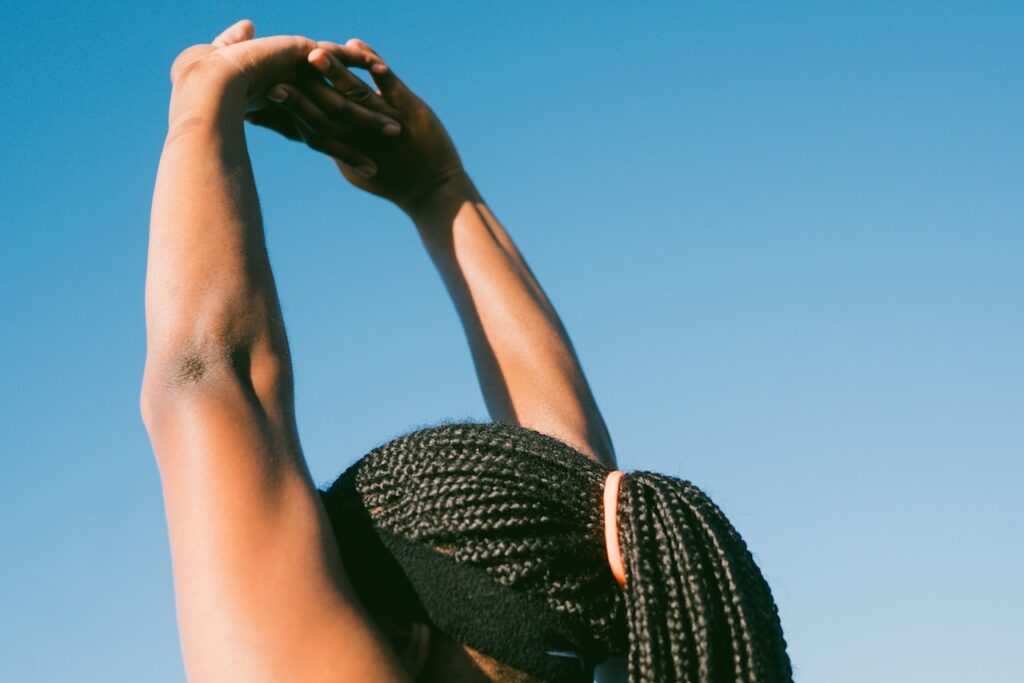
Make sure to warm up before doing squat thrusts to prevent injuries. A few minutes of light cardio, such as jogging or jumping jacks, can get your heart rate up and prepare your muscles for the workout.
After your workout, take a few minutes to stretch to improve flexibility and prevent muscle soreness.
Choosing the Right Surface
You can do squat thrusts on any surface, but it’s important to choose a surface that is safe and comfortable.
Avoid hard surfaces like concrete or asphalt, and opt for a mat or carpeted area instead.
Breathing Technique
It’s important to maintain proper breathing technique when doing squat thrusts. Inhale as you lower into the squat position, exhale as you jump into the plank position, and inhale again as you return to the squat position.
Squat Thrust FAQs
1) Are squat thrusts better than burpees?
Both squat thrusts and burpees are effective full-body exercises that provide similar benefits. Squat thrusts are generally considered a simpler and more beginner-friendly exercise, while burpees are more challenging and require more coordination.
It depends on your fitness and preference level. A beginner might like squat thrust more. And an active/regular member might like burpees more.
2) What muscles do squat thrusts work?
Squat thrusts engage multiple muscle groups, including your quads, hamstrings, arms, shoulders, core, and glutes.
3) Can squat thrusts help you lose belly fat?
Squat thrusts are a high-intensity exercise that burns calories and fat, which can help you achieve your weight loss goals.
However, spot reduction is not possible, so you’ll need to incorporate other exercises and a healthy diet to reduce belly fat.
4) Should I do squat thrusts every day?
Like any exercise, it’s important to give your muscles time to rest and recover between workouts.
Aim to do squat thrusts 2-3 times per week, with at least a day of rest in between. This will allow your muscles to repair and rebuild, and help prevent injuries.
5) Can squat thrusts help with cardiovascular fitness?
Yes, squat thrusts are a high-intensity exercise that can help improve cardiovascular fitness. By raising your heart rate and challenging your muscles, squat thrusts can improve your endurance and overall fitness level.
Conclusion
Squat thrusts are a simple yet effective exercise that can provide numerous benefits for your overall health and fitness. Whether you’re a beginner or an advanced exerciser, incorporating squat thrusts into your workout routine can help you build strength, increase endurance, and improve flexibility and mobility. By following the tips and precautions outlined in this article, you can safely and effectively perform squat thrusts and enjoy the many benefits they have to offer.
FAQs
- Are squat thrusts suitable for beginners?
- Yes, squat thrusts can be modified to suit different fitness levels, making them a great exercise for beginners.
- Can squat thrusts help improve posture?
- Yes, squat thrusts engage your core and back muscles, which can help improve posture over time.
- How many calories can you burn doing squat thrusts?
- The number of calories you burn doing squat thrusts depends on your weight and intensity level, but it can range from 8-12 calories per minute.
- Is it normal to feel sore after doing squat thrusts?
- Yes, it’s normal to feel sore after doing squat thrusts, especially if you’re new to the exercise or have increased the intensity level. Make sure to stretch and give your muscles time to recover.
- Can squat thrusts be done with weights?
- Yes, you can add weights to your squat thrusts to increase the challenge and build more strength. Start with light weights and gradually increase as you get stronger.

